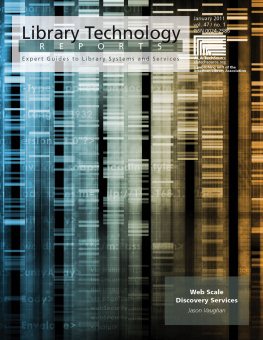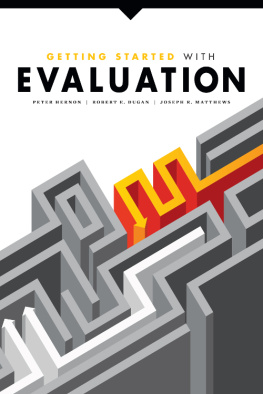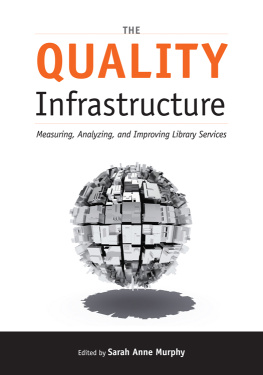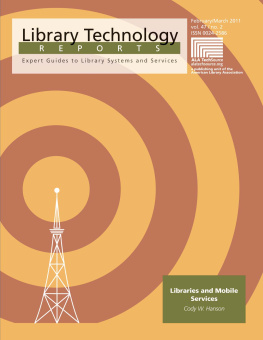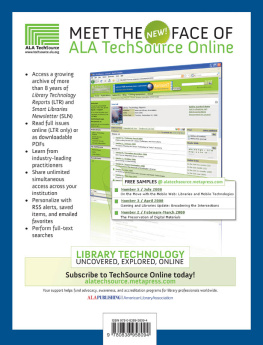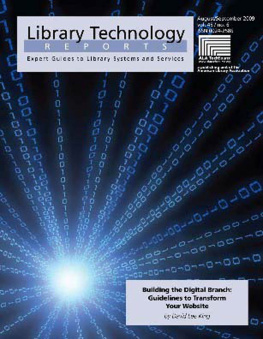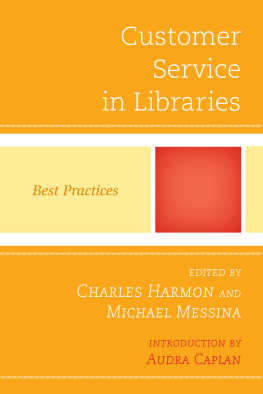Library Technology
REPORTS
ALA TechSource purchases fund advocacy, awareness, and accreditation programs for library professionals worldwide.
Volume 47, Number 1
Web Scale Discovery Services
ISBN: 978-0-8389-9221-0
American Library Association
50 East Huron St.
Chicago, IL 60611-2795 USA
alatechsource.org
800-545-2433, ext. 4299
312-944-6780
312-280-5275 (fax)
Advertising Representative
Brian Searles, Ad Sales Manager
ALA Publishing Dept.
bsearles@ala.org
312-280-5282
1-800-545-2433, ext. 5282
Editor
Dan Freeman
dfreeman@ala.org
312-280-5413
Copy Editor
Judith Lauber
Editorial Assistant
Megan O'Neill
moneill@ala.org
800-545-2433, ext. 3244
312-280-5275 (fax)
Production and Design
Tim Clifford, Production Editor Karen Sheets de Gracia, Manager of Design and Composition
Library Technology Reports (ISSN 0024-2586) is published eight times a year (January, March, April, June, July, September, October, and December) by American Library Association, 50 E. Huron St., Chicago, IL 60611. It is managed by ALA TechSource, a unit of the publishing department of ALA. Periodical postage paid at Chicago, Illinois, and at additional mailing offces. POSTMASTER: Send address changes to Library Technology Reports, 50 E. Huron St., Chicago, IL 60611.
Trademarked names appear in the text of this journal. Rather than identify or insert a trademark symbol at the appearance of each name, the authors and the American Library Association state that the names are used for editorial purposes exclusively, to the ultimate beneft of the owners of the trademarks. There is absolutely no intention of infringement on the rights of the trademark owners.

alatechsource.org
Copyright 2011 American Library Association All Rights Reserved.
About the Author
Jason Vaughan is the director of library technologies at the University of Nevada, Las Vegas (UNLV). In this capacity, he serves as a senior administrator and provides overall leadership for three units within the UNLV University Libraries: Digital Collections, Library Systems, and Web and Application Development. Vaughan earned his MLS and BA from the University of North Carolina at Chapel Hill. Previous positions at UNLV include Head of Library Systems and Information Systems Librarian. He has published extensively on library and library technology topics, including library automation, digitization, planning, and policy. To date Vaughan has served as coauthor and investigator on three funded LSTA grants and has most recently focused on delivering web scale discovery talks at the local, state, and national levels.

Abstract
Web scale discovery services for libraries are services capable of searching quickly and seamlessly across a vast range of local and remote preharvested and indexed content, providing relevancy-ranked results in an intuitive interface expected by today's information seekers. The fist of these services debuted in late 2007, with the majority of services reaching initial public release in 2010. This report reviews web scale discovery services tailored to the library environment and explores why libraries should take notice of these tools.
This report describes in detail the content, interface, and functionality of web scale discovery services developed by four major library vendors: OCLC, Serials Solutions, Ebsco, and Ex Libris. Each of these services is evolving rapidly, indicative of their open framework design and an ongoing expansion of indexed content as additional publisher and aggregator agreements are brokered. Although many similarities among the services are apparent, this report also outlines some observed differences, though these differences are becoming hazy as each vendor adds new functions, features, and content.
To help individual libraries evaluate which service will best meet the needs of the library and its community, this report provides detailed evaluation questions and concludes with a section providing additional background information on each service.
Subscriptions
alatechsource.org/subscribe
What and Why?
Abstract
Web scale discovery services for the library environment have the capacity to more easily connect researchers with the library's vast information repository. This includes locally held and hosted content, such as physical holdings, digital collections, and local institutional repositories. Perhaps more signifcantly, web scale discovery also accesses a huge array of remotely hosted content, often purchased or licensed by the library, such as publisher and aggregator content for tens of thousands of full-text journals, additional content from abstracting and indexing resources, and content from open access repositories.
This chapter defines web scale discovery and highlights a few key concepts essential for understanding these services. For anyone who has worked a reference interview and heard a student utter, I couldn't find an article in the library catalog, web scale discovery services hold tremendous potential. Extensive research on user expectations in the discovery arena, and the tools used by those seeking informationtools often disassociated from the library and often overlooking much of what the library holds and licensesprovide ample rationale for why web scale discovery is important for the library environment.
Connecting users with the information they seek is one of the central pillars of our profession. Succinctly put, Web scale discovery can be considered as deep discovery within a vast ocean of content. The mechanics behind Web scale discovery are not necessarily new, though a commercial application of this approach within the library environmentefciently and, it's hoped, efectivelyis very new. While there are various approaches to Web scale discovery, this issue of Library Technology Reports will focus on what today appears to be the most common approach, which, at its heart, involves huge, centralized, preaggregated indexes searched by the end user.
Expanded further, Web scale discovery isor certainly holds the potential to bethe evolution that libraries have long sought for information discovery. As information professionals, we all have at least a general awareness of the evolution of discovery tools within the library context. Such tools initially were print-based, such as bound handwritten catalogs, the card catalog, and works such as Poole's Index to Periodical Literature and the Reader's Guide to Periodical Literature. For the past several generations, such tools gradually transferred into the automated, electronic realm, with an obvious example the development and evolution of the online integrated library system (ILS) with a front-end catalog accessible to librarians and end users. These catalogs were initially available within the local library's physical building, often through a menu-driven, text-based interface. With the development in the 1990s of the Web's physical infrastructure and the empowerment of many to access this new environment, library vendors created HTTP Web-based online catalogs. Other evolutions included early pioneers in broad online information systems, including Dialog and LexisNexis. The 1990s ushered in growth in publisher-based electronic journal content, e-text and e-book content, abstracting and indexing databases, and full-text content aggregators looking to pull related information together within an easily accessible and searchable electronic medium. Many of these services or products were initially provided on CD-ROM or through text-based, menu-driven networked systems, which all eventually evolved into information search and delivery through a Web-based environment.

